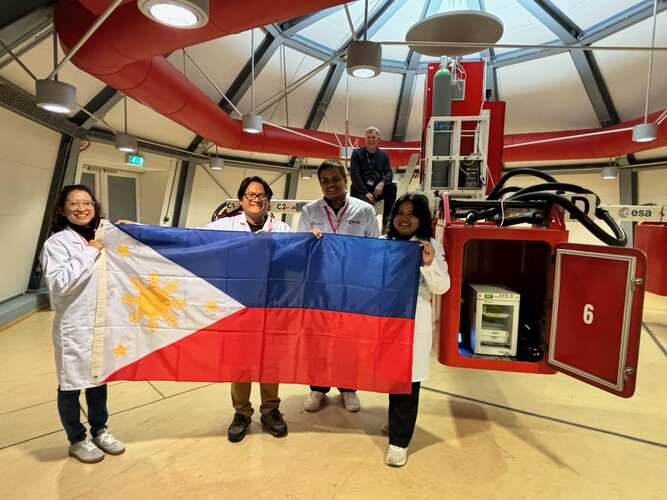
Copernical Team
More NASA science and technology set for Lunar delivery with Firefly Aerospace
 NASA is expanding its lunar exploration efforts by awarding Firefly Aerospace a $179 million contract to deliver six scientific experiments to the Moon. This marks Firefly's fourth task order under NASA's Commercial Lunar Payload Services (CLPS) initiative, targeting a landing at the Gruithuisen Domes on the Moon's near side in 2028.
Part of the Artemis program, this mission will focus on
NASA is expanding its lunar exploration efforts by awarding Firefly Aerospace a $179 million contract to deliver six scientific experiments to the Moon. This marks Firefly's fourth task order under NASA's Commercial Lunar Payload Services (CLPS) initiative, targeting a landing at the Gruithuisen Domes on the Moon's near side in 2028.
Part of the Artemis program, this mission will focus on Five Ways to Explore NASA's Portfolio of Technologies with TechPort 4.0
 Have you ever wanted to find all your favorite NASA technology in one place? NASA stakeholders did, too! We listened to your feedback, brainstormed user-focused features, and created the most robust technology system to date.
NASA's Space Technology Mission Directorate is excited to announce the release of TechPort version 4.0 - your gateway into our technology community. NASA tuned into f
Have you ever wanted to find all your favorite NASA technology in one place? NASA stakeholders did, too! We listened to your feedback, brainstormed user-focused features, and created the most robust technology system to date.
NASA's Space Technology Mission Directorate is excited to announce the release of TechPort version 4.0 - your gateway into our technology community. NASA tuned into f Space Gardens
 As NASA plans missions to the Moon and Mars, one challenge is figuring out how to provide crew members with enough healthy food. Bringing along a supply for months or even years in space is impractical, and stored food can lose taste and nutritional value. Growing plants in space is one way to help solve this problem. Tending space gardens also has positive psychological effects for crew members
As NASA plans missions to the Moon and Mars, one challenge is figuring out how to provide crew members with enough healthy food. Bringing along a supply for months or even years in space is impractical, and stored food can lose taste and nutritional value. Growing plants in space is one way to help solve this problem. Tending space gardens also has positive psychological effects for crew members Second Ariane 6 components assembled at Europe's Spaceport
 The assembly of Europe's second Ariane 6 rocket, designated VA263, is underway at Europe's Spaceport in French Guiana following the arrival of its primary components. The core and upper stages were shipped from France and Germany aboard the innovative vessel Canopee, marking a significant milestone in the launch campaign.
The Canopee ship, specially designed to use wind-powered sails, redu
The assembly of Europe's second Ariane 6 rocket, designated VA263, is underway at Europe's Spaceport in French Guiana following the arrival of its primary components. The core and upper stages were shipped from France and Germany aboard the innovative vessel Canopee, marking a significant milestone in the launch campaign.
The Canopee ship, specially designed to use wind-powered sails, redu Vega poised for expanded operations and next-gen development
 ESA has signed a series of contracts with Avio to enhance the operational capacity of the Vega-C rocket and push forward the development of its successor, Vega-E. These agreements aim to increase the annual launch frequency and advance next-generation rocket technologies.
The contracts cover three key areas: upgrading Vega-C ground systems to support a higher launch cadence, advancing the
ESA has signed a series of contracts with Avio to enhance the operational capacity of the Vega-C rocket and push forward the development of its successor, Vega-E. These agreements aim to increase the annual launch frequency and advance next-generation rocket technologies.
The contracts cover three key areas: upgrading Vega-C ground systems to support a higher launch cadence, advancing the 2 Russian cosmonauts perform spacewalk outside ISS
 Two Russian cosmonauts will perform a spacewalk outside the International Space Station to install an experiment package on one of the modules on Thursday morning.
Alexey Ovchinin and Ivan Vagner will leave the confines of the ISS to attach the package designed to monitor celestial X-ray sources and new electrical connector patch panels on the station's Poisk module.
Cosmonaut Al
Two Russian cosmonauts will perform a spacewalk outside the International Space Station to install an experiment package on one of the modules on Thursday morning.
Alexey Ovchinin and Ivan Vagner will leave the confines of the ISS to attach the package designed to monitor celestial X-ray sources and new electrical connector patch panels on the station's Poisk module.
Cosmonaut Al Apollo lunar mission samples reveal origins of lunar water and its connection to Earth's early history
This request seems a bit unusual, so we need to confirm that you're human. Please press and hold the button until it turns completely green. Thank you for your cooperation!
Press and hold the button
If you believe this is an error, please contact our support team.
185.132.36.159 : 40077ed2-e999-4382-b4f6-ac5435a3
SpaceX to launch more private astronaut missions to ISS
This request seems a bit unusual, so we need to confirm that you're human. Please press and hold the button until it turns completely green. Thank you for your cooperation!
Press and hold the button
If you believe this is an error, please contact our support team.
185.132.36.159 : 8957c9e4-0c9c-4553-8654-3b38f603
Philippines team add hypergravity for stronger bone cells

A team of researchers from two universities in the Philippines made use of ESA’s Large Diameter Centrifuge to test the growth of bone cells in hypergravity. The results of their experiment could improve bone implant technology, as well as help support seaweed farming communities across the country.
Second Ariane 6 at Europe’s Spaceport





































